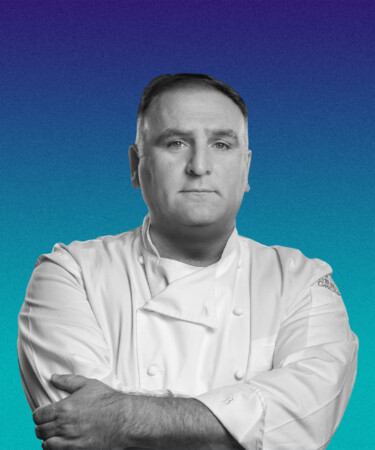From feeding the world during conflicts and crises to expanding his restaurant empire (he recently announced plans to open an outpost of his concept The Bazaar in the former Trump Hotel in Washington, D.C.), there’s seemingly nothing José Andrés can’t do. Fresh from relief missions with his World Central Kitchen to help those affected by the war in Ukraine and the devastating floods in Kentucky, now the veritable national treasure can add Olives from Spain ambassador to his lengthy resume.
Olives, after all, are the star in one of his playful dishes, an homage to his mentor Ferran Adrià of El Bulli in Catalonia. Made with reverse spherification, a molecular gastronomy parlor trick that mixes olive juice with sodium gluconate then drops the orbs into a water bath with sodium alginate, the trompe l’oeil is a surprising, bursting mouthful.
Andrés was born in Asturias — ironically, only one of two Spanish regions without commercial olive production — but has called the D.C. area home for the past 30 years. VinePair caught up with him at his flagship tapas hotspot Jaleo to talk about his affinity for the beloved green and black fruit, an up-and-coming Spanish grape, how wine forges connections, and his go-to Martini adorned with a savory bite.
[Editor’s note: This interview has been edited and condensed for clarity.]
1. So… what should we do with a freshly opened jar of olives?
Olives go with anything that is strange and amazing. Buy oysters, have your local fishmonger open them, top them with chopped Gordal olives, black pepper and Spanish olive oil, and serve them with a chilled Albariño from Rias Baixas. Or make risotto, shave white truffles, and add halved olives and shredded Manchego cheese; the brine will pair perfectly with the truffles and tangy cheese. The best dish, though, is aceitunas aliñadas, macerated olives. Mix in some of the curing brine, vinegar, pimenton, garlic, herbs, bay leaves, and lemon and orange peels. Oh my God!
2. What beverages can stand up to all that brininess?
Pairing Manzanilla Sherry with olives is wonderful — there is richness, an oily texture and salinity. White Txakolina offers spritz, saltiness, and bright acidity. A young red Garnacha without oak or a traditional rosé made with Garnacha is great as it tends to have a touch of sweet tannins. But most Spaniards actually pair olives with a local lager like Mahout, Estella, or San Miguel.
3. Olives also factor into your perfect Martini, right?
Yes. I like it a little bit dirty, shaken, and super cold. I don’t understand why anybody would have a Martini that is stirred. You have to shake it to put life into it and hope. Garnish it with two Campo Real olives wrapped in anchovy filets, skewered with a piquillo pepper. It’s a drink and a snack — you don’t have to go out for lunch.
4. Which Spanish region should wine fans pay attention to right now?
I am an investment partner and friend of Raúl Pérez, who makes amazing Spanish wines in Bierzo with Mencía, a grape that Americans haven’t yet discovered but are going to love. It’s a game changer — vibrant, elegant, young, and fresh. Sometimes fresh and young don’t go with elegant, and elegant can mean more mature and established. But this is astonishing. Bottles from the right winery can develop over 10 or 20 years, but in the right winemaker’s hands, Mencía is ready to drink right away. And that’s very rare these days.
5. Why has it taken so long to catch on in the States?
Bierzo is a small region, the wineries and vineyards are becoming some of the most expensive pieces of land in Europe, and most of the wine made there stays there. Raúl and Álvaro Palacios [who makes wine in Rioja and Priorat] are two of the top winemakers in Spain. They are best friends, almost like Jedis, very different in life but very similar in how they approach the vine. They often put their mark on the wine not by changing it, but by letting the grape and soil speak. They are soil whisperers.
6. What wines are particularly special to you?
I try not to open two bottles of the same wine in the same year. My favorite style is wine that is alive and fresh. I love Virginia wine. My wife and I have been going to local wineries for 30 years. In the beginning you could say we were biased because we met the winemakers and spent great weekends there in the winter when nobody goes. But we realized it wasn’t just because we were having a good time, it was also because of the winemakers, like Jim Law of Linden Vineyards. Every Thanksgiving I may have a Château d’Yquem, but tell me a wine with better quality and price than Jim’s Petit Manseng. I think it’s brilliant.
Serge Hochar of Lebanon’s Chateau Musar came to Zaytinya when I opened it almost 25 years ago. I promised him I would visit his winery but I never made it there. He died in 2014, and after the huge explosion in Lebanon in 2020, we went there to help, taking thousands of meals to Beirut and beyond. While the operation was running, I was able to visit the winery. And in the cellar he had some wines with my name that he was holding for me for the day I would visit him. That’s why Zaytinya has such a big selection of their wines. We are united — not through business, but through friendship over the years.
This story is a part of VP Pro, our free platform and newsletter for drinks industry professionals, covering wine, beer, liquor, and beyond. Sign up for VP Pro now!
